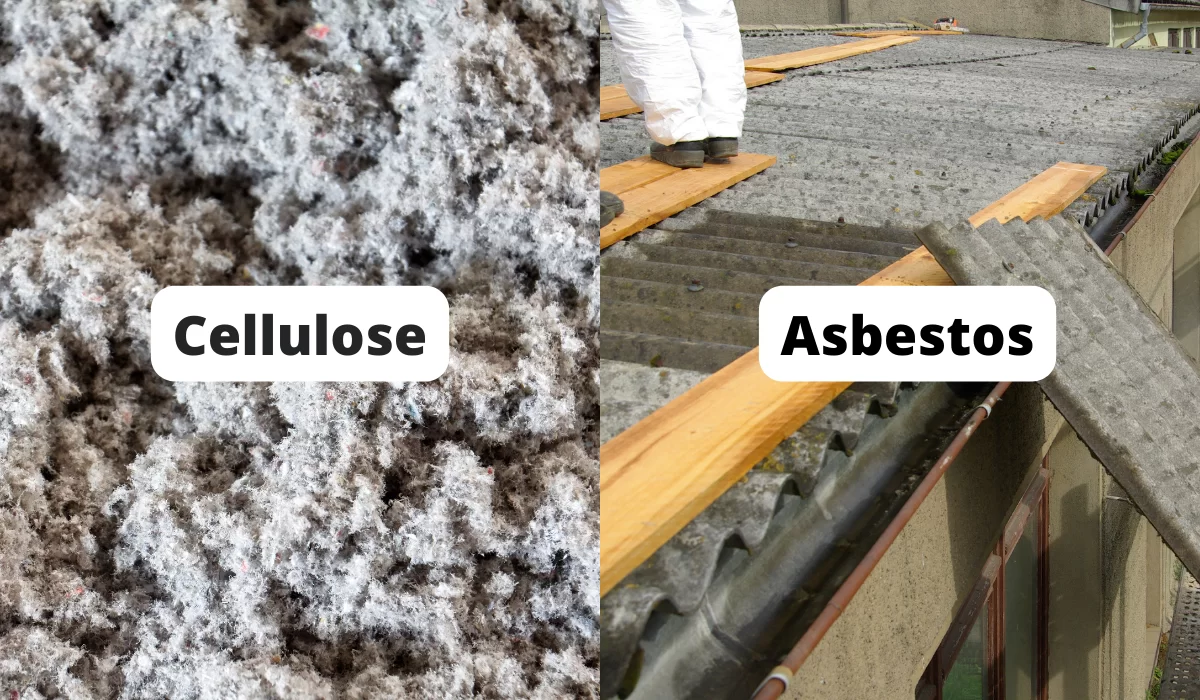How To Tell The Difference Between Cellulose And Asbestos Insulation

How To Tell The Difference Between Cellulose And Asbestos Insulation: Asbestos was used for insulation until recently. After widespread awareness, cellulose was substituted for asbestos. Older homes have asbestos insulation. Is your home’s insulation asbestos-free? How does cellulose and asbestos insulation differ?

It’s difficult to distinguish between cellulose and asbestos. However, cellulose insulation is grey and has the appearance of shredded paper, while asbestos insulation is often pebble-like and is grayish brown or solver-gold. Additionally, the look of various insulations varies due to the variable levels of asbestos employed in them. It is advisable to seek an expert to evaluate the issue if you suspect that the insulation in your home contains asbestos. Enough Info
Read Also: How To Find Motivation To Achieve Your Goal
FAQs & Answers
1, What are the key differences between cellulose and asbestos insulation?
The main difference between cellulose and asbestos insulation is that cellulose is composed of recycled paper products, while asbestos is a naturally occurring mineral fiber. Cellulose has excellent thermal and acoustic insulation properties, while asbestos has superior fire resistance. Additionally, cellulose is odorless and non-toxic, while asbestos can pose serious health risks when disturbed or not handled properly.
2, How do I know if I have cellulose insulation?
You most likely have cellulose insulation if your loose-fill insulation is gray, mushy, and unpolished. Cellulose is devoid of minerals and includes a significant amount of recycled paper. Comparable to shredded gray paper, cellulose has a distinct appearance from asbestos insulation.
3, What color is blown in cellulose insulation?
Because it contains up to 85% recycled materials, cellulose insulation is very eco-friendly. It often has a gray or brown tint. How To Adjust Chacos(2023 Guide)
Read Also: How To Protect Your Children From Child Abuse
Asbestos vs. Cellulose Insulation Differences
Asbestos Insulation
The majority of individuals are unaware that asbestos is a mineral element. Although most asbestos is soft and pliable, it possesses good heat and corrosion resistance qualities. For more than 40 years beginning in the early 1950s, asbestos was used in the building industry as an insulating material and a fire retardant. You may still find asbestos in the drywall tiles and the attic of older buildings and residences. The house is regarded as being in excellent condition since there are no damages or walls that expose asbestos fibers in the living spaces. When asbestos fibers are airborne and enter the spaces of the building you live in, there is a very real danger to your health. How To Stop On Skis( Ultimate Steps and Guide)
Cellulose Insulation
The Insulation made from cellulose, an alternative to asbestos, is made from a variety of materials, including hemp, cardboard, newspaper, straw, and other things. Boric acid is used in cellulose and paper mixtures used in buildings in order to provide them with fire-resistant properties.
Dry cellulose and cellulose insulation are the two most common varieties. It is also known as loose-fill insulation at times. The cellulose may be blown within the wall using holes and a blower. It may also be used to fill up holes in walls. On newly built walls, builders have the option of using the wet spray. The addition of water to the spraying is the primary contrast between wet spray and dry cellulose. It strengthens the seal, which will stop heat loss.
Similar to asbestos, cellulose works well inside pipes, walls, and electrical wires. In addition to generating insulation for your house, it aids in minimizing fires. Cellulose is a big asset for building owners looking to become green since it is also a recyclable material. How To Overcome Failure( Ultimate Guide)
The Distinctions
They seem to be the same when inspected if you are familiar with the various components. Vermiculite insulation has a lot of the same issues as other types of insulation, despite the fact that it is far more difficult to tell whether asbestos is present within. The best course of action is to keep your distance while enlisting the aid of a specialist who will collect specific samples and establish if it contains asbestos. If asbestos is found, it is advised to think about getting rid of it or putting in place an asbestos management strategy.
Asbestos and asbestos-containing items are dangerous and should be avoided. Whether you are unsure if your building contains asbestos, you should hire experts to assess it and make any necessary changes to limit or eliminate contamination and exposure.
Advantages Of Cellulose
Environment-Friendly
The fact that cellulose is environmentally benign is one of the main factors contributing to its widespread usage and preference as an insulating material today. It is created from recycled and repurposed materials that would have otherwise ended up in landfills, as was already indicated.
Read Also: How To Manipulate Energy(Step by step)
Low Levels of VOC
Blown-in cellulose contains extremely low amounts of volatile organic compounds (VOCs), a substance that may be harmful to the environment and people’s health, according to research by Healthy Building Science. The actual total VOC (TVOC) for this kind of insulation is thought to be far lower than that which is permitted for goods that have received GREENGUARD approval. How To Get A Business License( All you Need to Know)
Soundproofing
If you want a calmer atmosphere or live next to train or highway lines, cellulose insulation is the best choice for your home. Since it is denser than the majority of insulation materials, it has excellent soundproofing qualities.
Disadvantages Of Cellulose
Not Waterproof
By nature, cellulose is not waterproof. It may be given various treatments during construction to make it somewhat water-resistant. However, if it is exposed to dampness for an extended period of time, it might result in serious issues like mold.
Fire Hazard
Recycled paper makes up the majority of the cellulose, making it flammable if insulation is not covered with fire retardants. To reduce the possibility of this happening, all national building regulations demand that cellulose insulation be treated with fire retardants prior to use.
Advantages of Asbestos
- Because asbestos is a substance with high heat resistance, it does not burn quickly.
- This may provide a building with a high thermal insulation capacity, which is energy-efficient.
- It is also resistant to the elements.
- Older buildings still have asbestos insulation because of its exceptional durability.
- The material is less expensive.
- It is very easy to clean and maintain. How To Create A New Apple ID(Step by Step)
Read Also: How To Get Pop-corn Kernel Out Of Throat
Disadvantages of Asbestos
The majority of you are probably well aware of the tremendous damage asbestos causes to both human and environmental health. The material contains fibrous microparticles that, if ingested or breathed, may result in a number of ailments.
Dangers
Microscopic fibers produced by asbestos may be inhaled or ingested and can result in a variety of health issues. because it takes a very long time for the body to break down the harmful fibers in asbestos. Inflammation of the lungs, ovarian cancer, lung cancer, mesothelioma, genetic cell damage, and several other ailments of a similar kind are possible outcomes. All countries have outlawed the use of asbestos in insulation because of the dangers it poses. Vermiculite is one such asbestos-containing insulating material that has to be identified and replaced.
How Should I Handle Suspicious Insulation?
If your insulation is loose and follows vermiculite visual signs, the material should not be disturbed. When asbestos fibers are airborne and inhaled, the danger is highest. Insulation considerably lowers the likelihood of exposure if left unattended. How To Stop Someone From Mirroring Your Phone(2023)
You may use the asbestos-testing kit to inspect your insulation for asbestos or send samples to a recognized laboratory for testing. If your insulation contains asbestos, you may leave it or have a local business remove it.
Visit the US Environmental Protection Agency website for further information on dealing with vermiculite insulation (EPA).
Conclusion
Based on the information available, it is clear that cellulose and asbestos insulation differ in composition, flammability, health hazards, and effectiveness as insulation material. Cellulose insulation is non-flammable, non-toxic, and an efficient thermal insulator. Asbestos insulation, produced from naturally occurring fibers of silica and magnesium silicates, is extremely combustible, dangerous to inhale or consume, and less thermally efficient than cellulose. It is therefore important to consult a professional installer or inspector before making a decision on which type of insulation to use. How To Remove Tartar From Teeth Without a Dentist
Read Also: How To Stop On Skis( Ultimate Steps and Guide)




